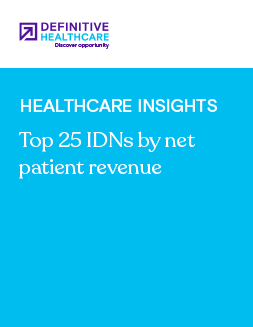Healthcare Insights
Reviewing hospital financial performance - average U.S. hospital EBITDA
With rising healthcare costs – from medical supplies to salary expenses – and thin operating margins, hospital leaders and executives always keep a close eye on their financial spreadsheets.
In accounting, EBITDA, or earnings before interest, taxes, depreciation, and amortization, is a variation of operating income that can indicate levels of an organization’s cash flow.
In the Definitive Healthcare HospitalView product, we calculate EBITDA using metrics from the Medicare Cost Report (MCR).
This Healthcare Insight reviews hospital EBITDA based on hospital size and geographic location. Results in this analysis are according to the last five calendar years of hospital financial performance tracked in our database, excluding the 2024 fiscal year.
In addition, when determining the average EBITDA by bed size or by region, we combined the five-year averages to account for the impact of COVID-19.
Average hospital EBITDA
Fig. 1 Data is from the Definitive Healthcare HospitalView product and sourced from the Medicare Cost Report. Results in this analysis are according to the last five calendar years of financial performance tracked in our database. Accessed July 2025.
What is the average U.S. hospital EBITDA?
The average hospital EBITDA in 2023 was about $1.4 million. In 2022, the average hospital EBITDA was -$358,332, likely reflecting drops in their margins from reduced capacity and delays in care or increasing costs as a result of the COVID-19 pandemic.
Hospital EBITDA by bed size
Fig. 2 Data is from the Definitive Healthcare HospitalView product and sourced from the Medicare Cost Report. Results in this analysis are according to the last five calendar years of financial performance tracked in our database. Accessed July 2025.
How does hospital EBITDA differ by bed count?
Larger hospitals – those with more than 101 patient beds – have higher EBITDA likely due to their higher revenues and expenses overall compared to smaller hospitals. More beds means the hospital can see more patients and earn more revenue. From the data, however, we can see that hospitals in the 101-250 bed bracket had a higher average EBITDA than hospitals with 250 or more beds.
However, hospitals with between 26 and 100 beds have the highest average EBITDA as a percentage of net patient revenue—3.0%. The higher EBITDA percentages correlate to operating margins by bed size where hospitals of these sizes had positive margins compared to the smallest and largest hospitals across the country.
Hospital EBITDA by region
Fig. 3 Data is from the Definitive Healthcare HospitalView product and sourced from the Medicare Cost Report. Results in this analysis are according to the last five calendar years of financial performance tracked in our database. Accessed July 2025.
How does hospital EBITDA differ by location?
Hospitals in the northeastern U.S. have the lowest average EBITDA by dollar amount (about -$22 million) and nearly the lowest average EBITDA as a percentage of NPR (-6.4%). Hospitals in the southeast and southwest appear to trend higher with average EBITDA as a percentage of NPR of 5.7% and 3.9% respectively. Hospitals in the west have the lowest average EBITDA that trends positively, at 0.4%.
Learn more
Healthcare Insights are developed with data from the Definitive Healthcare platform. Want even more insights? Start a free trial now and get access to the latest intelligence on hospitals, physicians, and other healthcare providers.


